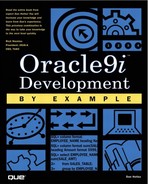Answers to Chapter 1
 | Reviewing It |
| 1: | What is a relational database? |
| A1: | The relational database supports a single, “logical” structure called a relation, a two-dimensional data structure commonly called a table in the database |
| 2: | What is the difference between a primary key and a unique key? |
| A2: | Unlike primary keys, unique keys can contain null values |
| 3: | Who is considered the father of relational databases? What was the first SQL language called? What company produced the first working relational database? |
| A3: | Dr. E. F. Codd, SEQUEL, Relational Systems, Inc (later became Oracle Corp) |
| 4: | The type of SQL used to update data, delete rows, and so on is known as what? The type of SQL used to create objects is known as what? |
| A4: | DML and DDL |
| 5: | What is Deja-view? |
| A5: | The ability to produce a result set based on a particular time (utilizing Oracle's read-consistent view mechanism) |
| 6: | List-partitioning is useful for what? |
| A6: | partition data based on character data |
| 7: | How does Data Pump work? |
| A7: | treat operating-system files as Oracle tables for the purposes of data loading |
| 8: | What would be a good use of having multiple buffer pools? |
| A8: | Gives the DBA the ability to further separate various types of object access from other types of object access |
| 9: | What is the old name for Net8? |
| A9: | SQL*Net |
| 10: | Describe the basic role of DBA Studio. |
| A10: | Oracle click 'n shoot administrative tool |
| 11: | Describe Log Miner and what it might be useful for. |
| A11: | Displays information from the Oracle online and archive log files, creates UNDO and REDO SQL, and can audit a variety of user activities. |
 | Checking It |
| 1: | Oracle is (mark all that apply)
|
| A1: | b and d |
| 2: | ISAM and VSAM are examples of a network database True/False |
| A2: | False |
| 3: | Referential integrity is
|
| A3: | b |
| 4: | Which of the following statements is true:
|
| A4: | c |
| 5: | SQL is a procedural language in that it processes sets of records at a time rather than single records at a time. True/False |
| A5: | False (non-procedural language) |
| 6: | Object-oriented support in the Oracle RDBMS was first introduced with which version:
|
| A6: | b |
| 7: | Resumable SQL allows some Oracle processes/tools to pickup where it left off in the event of space-oriented errors. True/False |
| A7: | True |
| 8: | A compiler:
|
| A8: | a |
| 9: | SQL*Plus can:
|
| A9: | e. |
